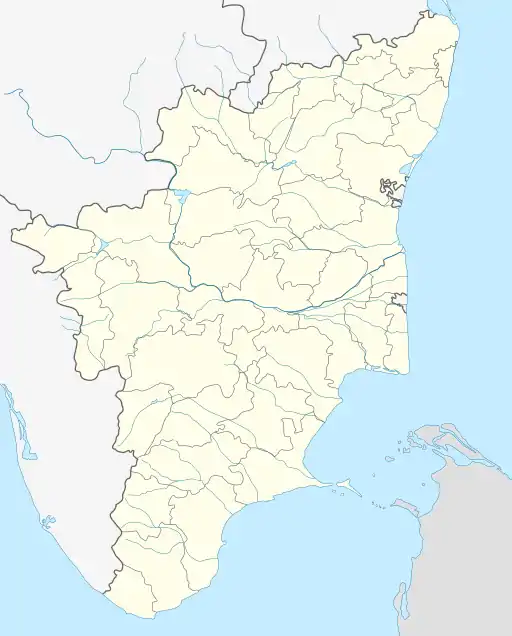Innambur Ezhutharinathar Temple
Innambur Ezhutharinathar Temple (இன்னம்பூர் எழுத்தறிநாதேஸ்வரர் கோயில்)[1] is a Hindu temple dedicated to Shiva, located in Innambur, a village in the outskirts of Kumbakonam, in Thanjavur district in Tamil Nadu, India. Shiva is worshipped as Ezhutharinathar and his consort Parvati as Nithya Kalyani. Ona Kantheeswarar is revered in the 7th century Tamil Saiva canonical work, the Tevaram, written by Tamil saint poets known as the Nayanars and classified as Paadal Petra Sthalam, the 275 temples revered in the canon.
| Ezhutharinathar Temple | |
|---|---|
_16.jpg.webp) Image of the Innambur temple gopuram | |
| Religion | |
| Affiliation | Hinduism |
| District | Thanjavur |
| Deity | Ezhutharinathar (Shiva), Nithya Kalyani(Parvati) |
| Location | |
| Location | Innambur |
| State | Tamil Nadu |
| Country | India |
 Location in Tamil Nadu | |
| Geographic coordinates | 10°58′54″N 79°20′20″E |
| Architecture | |
| Type | Dravidian architecture |
The temple has a five-tiered rajagopuram, the entrance tower and all the shrines are enclosed in rectangular walls. The temple has four daily rituals at various times from 6:00 a.m. to 8 p.m., and three yearly festivals on its calendar, namely Margazhi Tiruvathirai during the Tamil month of Margazhi (December - January), Kodabisheakam during Chittirai (April - May) and Aipassi Annabishekam during Aippassi (October - November) being the most prominent. The temple is maintained and administered by the Hindu Religious and Endowment Board of the Government of Tamil Nadu.[2]
Legend
_11.jpg.webp)
As per Hindu legend, once the accountant Of the temple was asked to submit the accounts to the king. The accountant did not have the correct accounts during the time and feared punishment from the king. An ardent devotee of Shiva, the accountant prayed to the god to rescue him. Shiva, in the form of the accountant, submitted the accounts. The king was pleased and praised the accountant, who was amused at the events. He later realised that it was divine grace. Since Shiva came down and submitted the accounts, he came to be known as Ezhutharinathar.[3] As per another legend, the presiding deity was worshipped by an elephant.[4] There is also a belief that sage Agastya attained knowledge about grammar after worshipping Ezhutharinathar.[5]
Architecture
The temple is located 10 km (6.2 mi) north-west of Kumbakonam on the Kumbakonam - Thirupurambiyam road. Ezhutharinathar temple has a rectangular plan with two prakarams (outer courtyard) covering an area of 1 acre (0.40 ha) and a five-tiered rajagopuram (gateway tower) facing East. The central shrine faces east and houses the image of Ezhutharinathar (Shiva) in the form of the lingam made of granite and is believed to be a swayambhu (self manifested). There are shrines for Shiva's sons Ganesha (Vinayagar) and Kartikeya (Murugan), on either side of the sanctum entrance. The granite images of Nandi (the bull and vehicle of Shiva), a tall flag staff and a Balipeeta, the place of offering, axial to the sanctum. As in other Shiva temples of Tamil Nadu, the first precinct or the walls around the sanctum of Ona Kantheeswarar has images of Dakshinamurthy (Shiva as the Teacher), Durga (warrior-goddess) and Chandikeswarar (a saint and devotee of Shiva). The temple precinct is surrounded by granite walls. Following the legend of the elephant, the roof over the sanctum is in the form of an elephant, called Gajaprashta Vimana.[2][5]
Worship and religious practises
The temple priests perform the puja (rituals) during festivals and on a daily basis. The temple rituals are performed four times a day; Kalasanthi at 8:00 a.m., Uchikalam at 11:30 a.m., Sayarakshai at 6:30 p.m and Arthajamam at 8:00 p.m.. Each ritual comprises four steps: abhisheka (sacred bath), alangaram (decoration), naivethanam (food offering) and deepa aradanai (waving of lamps) for Ezhutharinathar and Nithya Kalyani. There are weekly rituals like somavaram (Monday) and sukravaram (Friday), fortnightly rituals like pradosham, and monthly festivals like amavasai (new moon day), kiruthigai, pournami (full moon day) and sathurthi. Margazhi Tiruvathirai during the Tamil month of Margazhi (December - January), Kodabisheakam during Chittirai (April - May) and Aipassi Annabishekam during Aippassi (October - November) are the three festivals celebrated in the temple.[2]
Religious significance

It is one of the shrines of the 275 Paadal Petra Sthalams - Shiva Sthalams glorified in the early medieval Tevaram poems by Tamil Saivite Nayanars Tirugnanasambandar and Tirunavukkarasar. Tirugnanasambandar describes the feature of the deity as:[6]
எழில்திக ழும்பொழி லின்னம்பர் மேவிய
நிழல்திகழ் மேனியி னீரே
நிழல்திகழ் மேனியீ னீருமை நினைபவர்குழறிய கொடுவினை யிலரே.
Tirunavukkarasar describes the feature of the deity as:[7]
மறியொரு கையர் போலும் மாதுமை யுடையர் போலும்
பறிதலைப் பிறவி நீக்கிப் பணிகொள வல்லர் போலும்
செறிவுடை யங்க மாலை சேர்திரு வுருவர் போலும்எறிபுனற் சடையர் போலும் இன்னம்ப ரீச னாரே.
References
- ta:இன்னம்பூர் எழுத்தறிநாதேஸ்வரர் கோயில்
- "Ezhutharinathar temple". Dinamalar. 2014. Retrieved 24 November 2015.
- G., Srinivasan (3 June 2011). "Innambur: temple village from the annals of history". The Hindu. Thanjavur. Retrieved 24 January 2016.
- Ayyar, P. V. Jagadisa (1991). South Indian shrines: illustrated. New Delhi: Asian Educational Services. p. 246. ISBN 81-206-0151-3.
- R., Dr. Vijayalakshmy (2001). An introduction to religion and Philosophy - Tévarám and Tivviyappirapantam (1st ed.). Chennai: International Institute of Tamil Studies. pp. 155–6.
- Tirugnanasambandar Tevaram, III: 95:7
- Tirunavukkarasar Tevaram, IV: 72:3
External links
| Wikimedia Commons has media related to Innambur Ezhutharinathar Temple. |
- "Ezhuthtarinthar Temple, Tiruinnambar". Shiva Temples of Tamilnadu, Paadal Petra Sivasthalangal.
_02.jpg.webp)
_03.jpg.webp)
